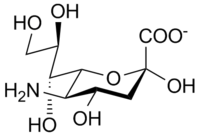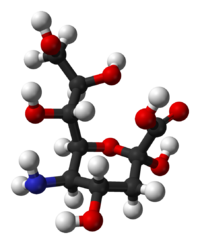- Neuraminic acid
-
Neuraminic acid 
 (4S,5R,6R,7S,8R)-5-amino-4,6,7,8,9-
(4S,5R,6R,7S,8R)-5-amino-4,6,7,8,9-
pentahydroxy-2-oxo-nonanoic acidIdentifiers CAS number 114-04-5 
PubChem 513472 ChemSpider 447972 
MeSH Neuraminic+Acids ChEBI CHEBI:49022 
ChEMBL CHEMBL165084  , CHEMBL1234621
, CHEMBL1234621Jmol-3D images Image 1 - O=C(O)[C@@]1(O)O[C@@H]([C@H](O)[C@H](O)CO)[C@H](N)[C@@H](O)C1
- InChI=1S/C9H17NO8/c10-5-3(12)1-9(17,8(15)16)18-7(5)6(14)4(13)2-11/h3-7,11-14,17H,1-2,10H2,(H,15,16)/t3-,4+,5+,6+,7+,9-/m0/s1

Key: CERZMXAJYMMUDR-YOQZMRDMSA-N
InChI=1/C9H17NO8/c10-5-3(12)1-9(17,8(15)16)18-7(5)6(14)4(13)2-11/h3-7,11-14,17H,1-2,10H2,(H,15,16)/t3-,4+,5+,6+,7+,9-/m0/s1
Key: CERZMXAJYMMUDR-YOQZMRDMBH
Properties Molecular formula C9H17N1O8 Molar mass 267.233 g/mol  acid (verify) (what is:
acid (verify) (what is:  /
/ ?)
?)
Except where noted otherwise, data are given for materials in their standard state (at 25 °C, 100 kPa)Infobox references Neuraminic acid (5-amino-3,5-dideoxy-D-glycero-D-galacto-non-2-ulosonic acid) is a 9-carbon monosaccharide, a derivative of a ketononose. Neuraminic acid may be visualized as the product of an aldol-condensation product of pyruvic acid and D-mannosamine (2-amino-2-deoxy-mannose). Neuraminic acid does not occur naturally, but many of its derivatives are found widely distributed in animal tissues and in bacteria, especially in glycoproteins and gangliosides. The N- or O-substituted derivatives of neuraminic acid are collectively known as sialic acids, the predominant form in mammalian cells being N-acetylneuraminic acid. The amino group bears either an acetyl or a glycolyl group. The hydroxyl substituents may vary considerably: Acetyl, lactyl, methyl, sulfate and phosphate groups have been found.
The name "neuraminic acid" was introduced by German scientist E. Klenk in 1941, in reference to the brain lipids from which it was derived as a cleavage product.[1].
The symbol commonly used for neuraminic acid is Neu, and the residue is typically found with additional chemical modifications in biological systems. As a family, these residues are known as sialic acids. For example, N-acetyl-neuraminic acid, Neu5Ac, is typical in human glycoproteins.
Among their many biological functions, these structures are substrates for neuraminidase enzymes which cleave neuraminic acid residues. Human flu viruses have a neuraminidase enzyme, signified in the name "H#N#", where the H refers to an isoform of hemaglutinin and N refers to an isoform of viral neuraminidase.
See also
References and notes
- ^ Klenk, E. 1941. Neuraminsäure, das Spaltprodukt eines neuen Gehirnlipoids. Zeitschr. f. Physiol. Chem. 1941; 268:50-58.
Categories:- Amino sugars
- Sugar acids
- Monosaccharides
Wikimedia Foundation. 2010.
